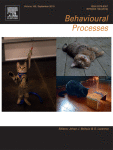Ver ítem
- xmlui.general.dspace_homeCentros Regionales y EEAsCentro Regional Buenos Aires SurEEA BarrowArtículos científicosxmlui.ArtifactBrowser.ItemViewer.trail
- Inicio
- Centros Regionales y EEAs
- Centro Regional Buenos Aires Sur
- EEA Barrow
- Artículos científicos
- Ver ítem
Are there different vigilance strategies between types of social units in Lama guanicoe?
Resumen
Group vigilance is a cooperative behaviour in social species that reduces individual risk of predation. Lama guanicoe is a social species of camelid performing cooperative vigilance, but little is known about the vigilance behaviour of different social units. We analysed the vigilance behaviour in different types of social units of L. guanicoe, to better understand the complexity of this behaviour. The best supported models for both the frequency of
[ver mas...]
Group vigilance is a cooperative behaviour in social species that reduces individual risk of predation. Lama guanicoe is a social species of camelid performing cooperative vigilance, but little is known about the vigilance behaviour of different social units. We analysed the vigilance behaviour in different types of social units of L. guanicoe, to better understand the complexity of this behaviour. The best supported models for both the frequency of vigilance and the proportion of time vigilant included the type and size of social units as the most important predictors that affect the vigilance behaviour. Solitary males devoted proportionally more time in vigilance behaviour than family, mixed or bachelor groups, whereas females in female groups spent more time vigilant than guanacos in mixed groups. Frequency of vigilance was higher in family individuals and solitary males than in bachelor or mixed groups. It is likely that that in family and females groups, the presence of offspring would increase the vigilance behaviour to detect possible predators. Topography and habitat characteristics that determine the predation risk, affected vigilance behaviour of mixed groups and solitary males. Our results suggest that vigilance behaviour should not be generalized for this species, since there are differences between the types of social units, probably related to intrinsic characteristics of each one and the perception of risk.
[Cerrar]

Autor
Taraborelli, Paula Andrea;
Moreno, Pablo Gastón;
Mosca Torres, Maria Eugenia;
Fuente
Behavioural Processes 167 : 103914 (October 2019)
Fecha
2019-10
Editorial
Elsevier
ISSN
0376-6357
Formato
pdf
Tipo de documento
artículo
Palabras Claves
Derechos de acceso
Restringido
 Excepto donde se diga explicitamente, este item se publica bajo la siguiente descripción: Creative Commons Attribution-NonCommercial-ShareAlike 2.5 Unported (CC BY-NC-SA 2.5)
Excepto donde se diga explicitamente, este item se publica bajo la siguiente descripción: Creative Commons Attribution-NonCommercial-ShareAlike 2.5 Unported (CC BY-NC-SA 2.5)

